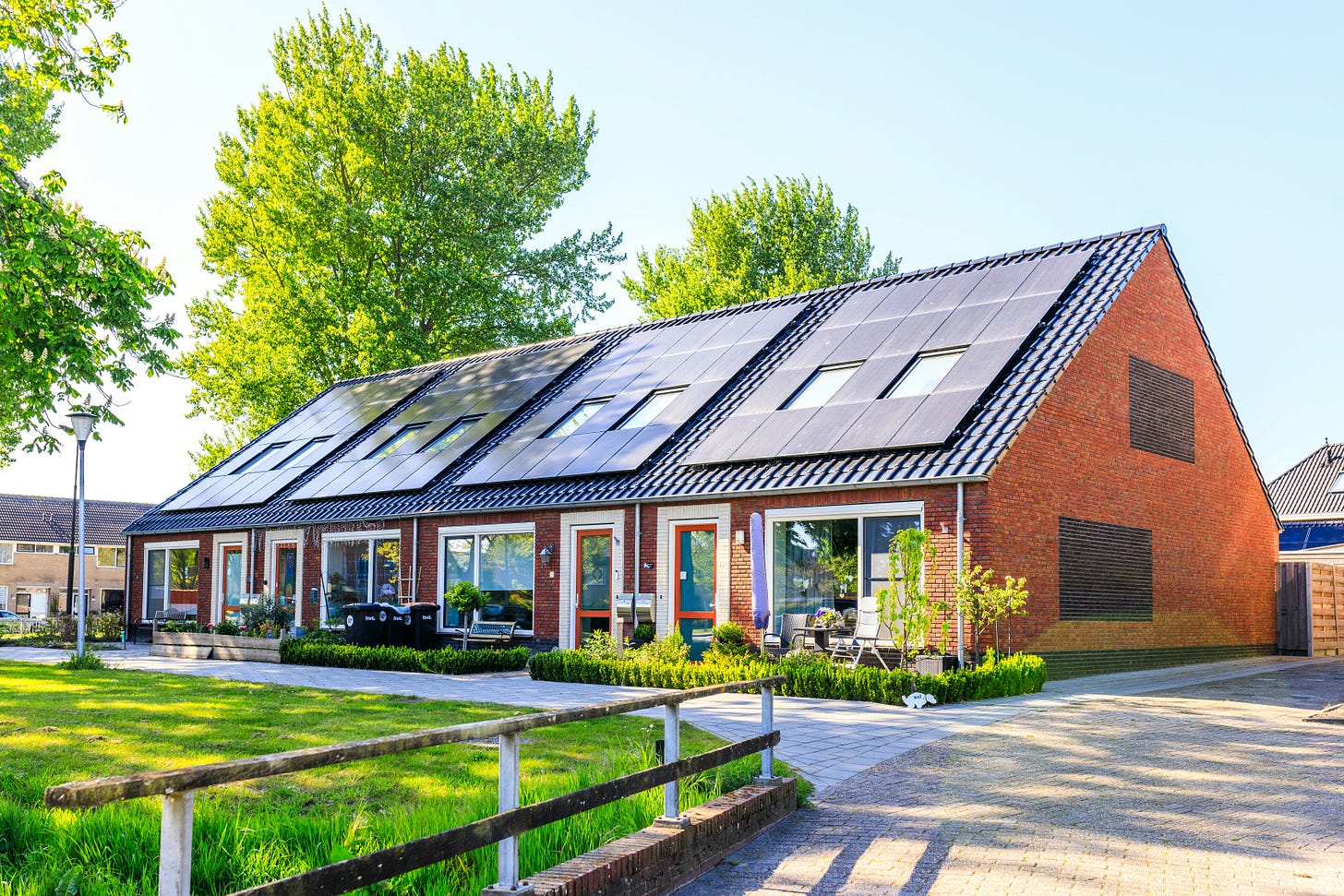Distributed energy resources and community wealth
Renewable Energy Isn't Just for Decarbonization
Robust and reliable energy infrastructure is critical to promote global wellbeing. Energy powers our homes, grows our food and cleans our water. Every year, our global community spends $300-400 billion dollars maintaining and expanding critical energy infrastructure.
Today, the dominant model for energy infrastructure are centralized power grids: energy resources are centrally owned and individual households participate as ratepayers. While fossil fuels have dominated these centralized grids in the past, we are now seeing integration of renewable energy resources like solar.
Recently, there has been increased interest in a new type of energy infrastructure: distributed energy resources (DERs). DERs are small scale generation technologies that can be deployed near or even at the use site. Rooftop solar panels are a common DER. When DERs are widely adopted, the grid can shift from a centralized system, where households participate as ratepayers, to a decentralized system, where households can generate some or all of their own energy.
DERs are lauded as an effective decarbonization strategy. And they are! Behind the meter energy resources are typically low carbon and renewable energy sources. But they are so much more than just a tool for decarbonization. Below, I outline three major benefits of DERs, beyond decarbonization: community wealth generation, transmission and distribution cost savings, and resilience.
Community Wealth Generation
As ratepayers, we participate in the energy system at an arm’s length. Centralized energy utilities own and manage energy infrastructure and to participate in the energy system, we send money out of our household and out of our community when we pay for the energy we consume. By using DERs, we can transform our relationship with energy finance in two critical ways.
First, as Lorenzo Kristov identifies in a recent podcast episode Envisioning a more democratic, bottom-up energy system, we live in an asset based economy, which means that the ownership of assets is one of the main pathways to build wealth. When households and communities own energy resources, these assets can increase local wealth. For instance, solar panels can increase the value of a home.
Additionally, when households and communities produce some or all of their own energy, they are able to reduce the funds flowing out of the community to centralized energy systems in the form of bill payments. A study by the IEA of 17 developed and developing countries found that households spend 3-7% of household income on energy. By diverting this revenue stream back into the household, individuals and families can use this money to meet other needs and build stronger local economies. Aggregation of DERs can also precipitate grid benefits, which stimulates further cost savings.
Transmission and Distribution Cost Savings
Under a centralized energy system, energy generation sites, like power plants and solar farms, are connected to use sites, like homes, through transmission and distribution infrastructure. Transmission infrastructure carries energy over long distances and distribution infrastructure transports energy locally and connects homes to the grid. Transmission and distribution infrastructure is expensive! The global transmission and distribution network was valued at 325 billion USD in 2024 and is already growing year over year.
When we generate some or all of our energy close to home, we reduce the need for more transmission and distribution infrastructure. In Iowa, the state’s first microgrid is expected to reduce transmission expenses by 34% and precipitate substantial cost savings for households and businesses. In regions with developing electricity systems, these savings are particularly material.
Energy System Resilience
As a result of climate change, natural disasters like fires and flooding will become more common and more extreme. I live in Ontario, Canada and just last month in March 2025, one million of my neighbours were without power because of a serious ice storm. Some people were without power for days or even weeks. Many of these outages were attributable to damaged transmission and distribution infrastructure. As climate change worsens, these events will become more common and electricity interruptions may even impact critical facilities like hospitals and grocery stores when the community needs them most. Unfortunately, in Ontario, most utilities still do not investigate the risk these climate events pose to the grid.
DERs help improve the climate resilience of our energy systems. By generating electricity close to home, transmission and distribution failures are less likely to result in interruptions to energy access for community members. In addition to physical climate risk, locally owned energy infrastructure can help ensure that communities are resilient to geopolitical risks, like recent tensions between Canada and the United States that have raised concerns surrounding energy security for some communities.
Distributed energy resources have many benefits. In addition to their role as a critical agent for the decarbonization of our grid, they also help communities build local wealth, save money on transmission and distribution costs, and improve the resilience of energy systems in the face of mounting climatic and geopolitical instability. Now more than ever, we need strong communities and this must start with autonomous local energy systems. Through energy independence and distributed energy resources, we can build strong local economies and move towards an energy system that meets the needs of all people, within planetary boundaries.
If you want to learn more about this topic, the above-mentioned podcast episode Envisioning a more democratic, bottom-up energy system is an excellent resource. In this episode, Lorenzo Kristov elaborates on some of the points raised above and dives into what local energy systems are all about and how we can get there.
Photo by Uitbundig



